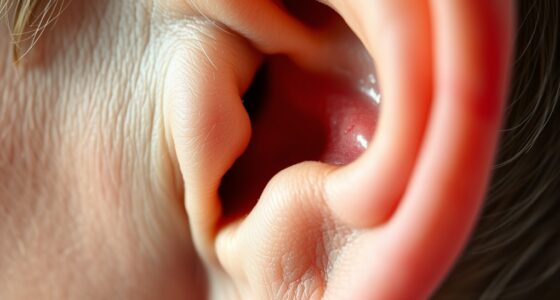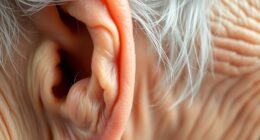If you’re looking for evidence-based treatments for hyperacusis, you’ll find that sound therapy and cognitive restructuring are highly effective. Sound therapy involves gradual exposure to tolerable sounds to help retrain your brain and reduce sensitivity, while cognitive techniques address negative thoughts and fears about normal noises. Combining these approaches under professional guidance can markedly improve your sound tolerance and quality of life. Keep exploring to discover how these methods can work for you.
Key Takeaways
- Evidence supports sound therapy using gradual, tailored sound exposure to desensitize hyperacusis sufferers effectively.
- Cognitive restructuring techniques help manage emotional responses, reducing anxiety and fear associated with normal sounds.
- Combining sound therapy with psychological strategies accelerates treatment progress and improves overall sound tolerance.
- Professional guidance from audiologists ensures safe, personalized treatment plans based on scientific research.
- Consistent, incremental exposure and therapy adherence are crucial for successful long-term symptom reduction.

Hyperacusis, a condition characterized by an increased sensitivity to normal sounds, can be distressing and disruptive. It often leaves you feeling overwhelmed in everyday environments, making simple activities like talking or walking outside seem unbearable. Fortunately, several evidence-based treatments have shown promise in managing these symptoms. Among them, sound therapy and cognitive restructuring stand out as effective strategies to help you regain control over your auditory environment and reduce discomfort.
Sound therapy involves exposing you gradually to sounds at tolerable levels, which helps desensitize your auditory system over time. This approach works by retraining your brain to interpret sounds more normally, reducing the exaggerated response you experience. Using specially designed devices or ambient noise generators, sound therapy creates a controlled environment for you to build tolerance without feeling overwhelmed. The key is consistency—regular, incremental exposure can lead to significant improvements in your sound tolerance. It’s important to tailor this therapy to your specific sensitivities, often under the guidance of an audiologist or trained therapist, to guarantee that the exposure is both safe and effective. Incorporating evidence‑based methods ensures that your treatment plan is grounded in proven scientific research.
Gradual sound exposure with tailored devices can desensitize hyperacusis over time.
Cognitive restructuring complements sound therapy by addressing the psychological response to hyperacusis. It involves identifying and challenging negative thoughts and beliefs you may have about sounds and your reactions to them. For example, if you fear that normal noises will cause pain or discomfort, cognitive restructuring helps you reframe these thoughts into more realistic and manageable perspectives. This mental shift reduces anxiety and fear related to sound exposure, making it easier for you to tolerate sounds during therapy sessions. Combining cognitive restructuring with sound therapy not only diminishes your physical sensitivity but also helps you manage the emotional and cognitive aspects of hyperacusis. This dual approach can accelerate your progress and improve your overall quality of life.
Implementing these treatments requires patience and a proactive attitude. You might start with short, daily sound exposure sessions while practicing cognitive restructuring exercises to manage anxiety. Over time, as your tolerance improves, you’ll likely notice a decrease in sound sensitivity and a reduction in distress. Remember, these methods are most effective when tailored to your specific needs and used consistently. Consulting with healthcare professionals experienced in hyperacusis treatment can guide you through the process, guaranteeing that you adopt safe practices and optimize your recovery. With dedication and support, sound therapy combined with cognitive restructuring offers a promising path toward reducing hyperacusis symptoms and reclaiming your auditory comfort.
Frequently Asked Questions
Are There Any Natural Remedies for Hyperacusis?
You might wonder if natural remedies can help your hyperacusis. While research is limited, some find herbal remedies like ginger or chamomile soothing, and dietary adjustments may reduce noise sensitivity. You should try incorporating anti-inflammatory foods or calming herbs into your routine. However, always consult a healthcare professional before making changes, as natural remedies work differently for everyone and should complement, not replace, medical treatments.
How Long Does Hyperacusis Treatment Typically Take?
The treatment duration for hyperacusis varies depending on severity and individual response. Typically, your recovery timeline can range from several weeks to a few months. Consistent therapy, like sound desensitization and counseling, helps speed up progress. You should expect gradual improvement as you adhere to your plan, but patience is key. Keep in close contact with your healthcare provider to monitor progress and adjust treatments as needed.
Can Hyperacusis Resolve on Its Own Without Treatment?
When it comes to hyperacusis resolving on its own, it’s a bit of a gamble—you might get lucky and see spontaneous recovery, thanks to your self-healing potential. However, it’s not something you should count on, as symptoms can persist or worsen without treatment. Think of it as riding a roller coaster—you never know when the ride will end. Consulting a professional can guide your best course of action.
Are There Age-Specific Hyperacusis Treatments?
You might wonder if there are age-specific hyperacusis treatments. Developmental considerations play a role, so therapies differ based on age. For children, gentle sound therapy and behavioral strategies work best, while adults may benefit from cognitive-behavioral therapy or sound desensitization. Age-specific therapies are tailored to developmental needs, ensuring the most effective approach. Consulting a specialist can help determine the best options for your age group.
Is Hyperacusis Linked to Other Neurological Conditions?
Did you know about 50% of people with hyperacusis also have other neurological conditions? You should know that hyperacusis often links to comorbid conditions like tinnitus or migraine. Your brain’s neuroplasticity potential means it can adapt, but these connections may complicate treatment. Recognizing these links helps you and your healthcare provider develop a more targeted approach, addressing both hyperacusis and any underlying neurological issues effectively.
Conclusion
Ultimately, you have effective options to manage hyperacusis and regain control over your life. From sound therapy to cognitive behavioral approaches, these evidence-based treatments offer hope and relief. Are you ready to take the first step toward a quieter, more comfortable future? Remember, with the right support and persistence, you can overcome the challenges of hyperacusis and find your peace again. Don’t wait—your journey to healing starts today.











